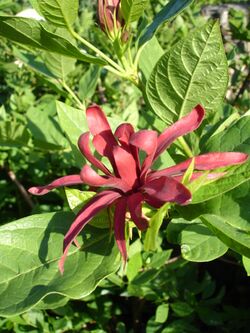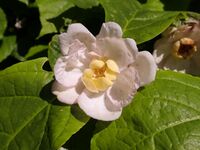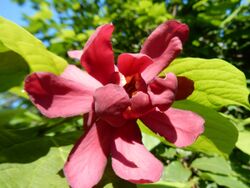Biology:Calycanthus
| Calycanthus | |
|---|---|

| |
| Calycanthus floridus | |
| Scientific classification | |
| Kingdom: | Plantae |
| Clade: | Tracheophytes |
| Clade: | Angiosperms |
| Clade: | Magnoliids |
| Order: | Laurales |
| Family: | Calycanthaceae |
| Genus: | Calycanthus L.[1] |
| Species | |
|
See text. | |
| Synonyms[1] | |
|
List
| |
Calycanthus, called sweetshrub,[2] is a genus of flowering plants in the family Calycanthaceae. The genus includes two to four species depending on taxonomic interpretation; three are accepted by most 21st century sources.
Description
Calycanthus plants are deciduous shrubs, growing to 4 m (13 ft) tall. The leaves are opposite and undivided. The plants are aromatic.[3][4][5][6] The flowers are typical of the family Calycanthaceae in lacking distinct sepals and petals, but instead having spirals of tepals.[7] Flowers are produced from spring onwards, until October in the case of C. occidentalis.[8] The flowers of the two North American species are scented, 4–7 cm (1.6–2.8 in) across, with numerous dark red to burgundy to purplish brown tepals. C. chinensis has broader tepals, the outer ones white flushed with pink, the inner ones mostly yellow with purple marks at the base.[5] The fruit is an elliptical dry capsule, containing numerous seeds.[citation needed]
C. floridus and C. occidentalis are pollinated by beetles. Their flowers produce small protein-rich growths that feed beetle pollinators.[9] C. occidentalis has been shown to produce chemicals that mimic fermenting fruits that attract beetles in the families Nitidulidae and Staphylinidae.[10]
Taxonomy
The genus Calycanthus was created by Carl Linnaeus in 1759,[11] with the sole species Calycanthus floridus.[12] In 1762, he added Calycanthus praecox, now treated as Chimonanthus praecox.[13]
Phylogeny and evolution
A 2006 molecular phylogenetic study of the family Calycanthaceae found that the three widely recognized species of Calycanthus formed a monophyletic group. Relationships among the three species differed depending on whether chloroplast or nuclear data was used. A cladogram obtained by combining the two is shown below.[9]
| Calycanthaceae |
| ||||||||||||||||||||||||
The family Calycanthaceae may have had a Gondwanan origin. The sole Australian representative, Idiospermum australiense, would then represent an ancient relic, probably having diverged in the Cretaceous. There are no extant South American members of the family, although fossils are known. Calycanthus may have migrated into North America from eastern Asia, or may have originated in South America, moved northwards and then spread to eastern Asia.[9]
Species
(As of February 2020), Plants of the World Online accepted four species:[1]
- Calycanthus brockianus Ferry & Ferry f.—north central Georgia; has greenish rather than brownish red flowers, and may only be a triploid color variant of C. floridus.[5]
- Calycanthus chinensis (W.C.Cheng & S.Y.Chang) W.C.Cheng & S.Y.Chang ex P.T.Li (syn. Sinocalycanthus sinensis)—Chinese sweetshrub, Chinese wax shrub, native to eastern China, with white flowers[14]
- Calycanthus floridus L.—Carolina spicebush, eastern sweetshrub, native to the Eastern United States, from New York and Missouri, south through the Appalachian Mountains, Piedmont, and Mississippi Valley, to Louisiana, and east to northern Florida[15]
- Calycanthus occidentalis Hook. & Arn.—California spicebush, western sweetshrub, native to moist habitats of California below 1,500 m (4,900 ft), including in the California Coast Ranges, San Joaquin Valley, and Sierra Nevada.[18][19] (As of February 2021), the Oregon Flora Project documented two specimens in Oregon, marked as "exotic?".[20]
C. chinensis has a confused taxonomic history. It was first described in 1963 as Calycanthus chinensis by W.C. Cheng and S.Y. Chang, but invalidly because two different collections were both given as holotypes. The authors then described it validly in 1964 in their new genus Sinocalycanthus. In 1979, P.T. Li rejected the genus Sinocalycanthus, and validated the original name Calycanthus chinensis.[5]
Cultivation
Calycanthus species are cultivated as ornamental plants by plant nurseries, including in the United States and England.
Calycanthus floridus is planted in gardens, as a specimen shrub, or for hedges.[21][22] The English naturalist Mark Catesby drew it as the support for the bird he called "Garrulus Carolinensis The Chatterer" (now Bombycilla cedrorum) in a work published from 1731 onwards. He described the shrub as growing in "remote and hilly parts" and having bark "as odoriferous as cinnamon".[23] The colonial planters of the Carolinas transplanted it into their gardens, and the botanist Peter Collinson described it to Linnaeus and imported it into England from Charleston in the Province of South Carolina around 1756.[24][page needed]
Calycanthus occidentalis is planted in traditional, native plant, and wildlife gardens, and for natural landscaping and habitat restoration projects, primarily in California and the Western United States.[25][26] It was introduced into cultivation in 1831.[8]
Calycanthus chinensis was introduced into cultivation in both the United States and the United Kingdom from the Shanghai Botanical Garden in the 1980s.[7][5] It has since been used extensively in the breeding of cultivars.[7]
Hybridization
Several hybrids and hybrid cultivars have been produced, with the intention of combining the larger flower size of C. chinensis with the colour and scent of the two North American species, as well as their greater hardiness. The hybrid between C. chinensis and C. floridus has been named C. × raulstonii. It combines the larger flowers of C. chinesis with the flower color of C. floridus. The original cross has been given the cultivar name 'Hartlage Wine' after the student, Richard Hartlage, who made the first crosses. Further crosses have been made. 'Venus' involves C. occidentalis as well.[5][7]
Hybrid cultivars include:[7]
- 'Aphrodite' (C. chinensis × C. occidentalis) – US; large reddish-purple flowers with yellow marks on the inner tepals, borne on relatively long stalks; long flowering season
- 'Hartlage Wine' (C. × raulstonii) – US, 1991; resembles C. chinensis in leaf and flower size, with the flower colour of C. floridus; may reach 2 m (7 ft) in height; given the Royal Horticultural Society's Award of Garden Merit[27]
- 'Hongyun' (C. × raulstonii) – China, 2001; large flowers of C. chinensis with the red colour of C. floridus
- 'Solar Flare' (C. × raulstonii) – US, 2003–2006; similar to 'Hartlage Wine' but with larger and thicker leaves and smaller flowers; appears to be hardier to frost than 'Hartlage Wine'
- 'Venus' (C. × raulstonii × [C. chinensis × C. occidentalis]) – large white flowers, marked with yellow and purple at the centre; strongly fragrant
Other uses
Calycanthus floridus and C. occidentalis were both used as a traditional medicinal plant by Native Americans. The indigenous peoples of California also used C. occidentalis in basketweaving and for arrow shafts.[28][29]
Essential oils
Calycanthus oil, distilled from the flowers, is an essential oil used in some quality perfumes.[30]
References
- ↑ 1.0 1.1 1.2 "Calycanthus L.". Board of Trustees of the Royal Botanic Gardens, Kew. https://powo.science.kew.org/taxon/urn:lsid:ipni.org:names:331448-2.
- ↑ Johnson, George P., "Calycanthus", in Flora of North America Editorial Committee, Flora of North America (online), eFloras.org, http://www.efloras.org/florataxon.aspx?flora_id=1&taxon_id=105270, retrieved 9 February 2021
- ↑ Johnson, George P., "Calycanthus floridus", in Flora of North America Editorial Committee, Flora of North America (online), eFloras.org, http://www.efloras.org/florataxon.aspx?flora_id=1&taxon_id=200008493, retrieved 9 February 2021
- ↑ Johnson, George P., "Calycanthus occidentalis", in Flora of North America Editorial Committee, Flora of North America (online), eFloras.org, http://www.efloras.org/florataxon.aspx?flora_id=1&taxon_id=233500303, retrieved 9 February 2021
- ↑ 5.0 5.1 5.2 5.3 5.4 5.5 Lancaster, Roy; Rix, Martyn (2019), "921. Calycanthus chinensis Calycanthaceae", Curtis's Botanical Magazine 36 (4): 340–346, doi:10.1111/curt.12302
- ↑ Li, Bingtao; Bartholomew, Bruce, "Calycanthus", in Wu, Zhengyi; Raven, Peter H.; Hong, Deyuan, Flora of China (online), eFloras.org, http://www.efloras.org/florataxon.aspx?flora_id=2&taxon_id=105270, retrieved 9 February 2021
- ↑ 7.0 7.1 7.2 7.3 7.4 Hsu, Eric (March 2018), "An overview of Calycanthus", The Plantsman, New Series 17 (1): 32–39
- ↑ 8.0 8.1 "Calycanthus occidentalis". Lady Bird Johnson Wildflower Center. http://www.wildflower.org/plants/result.php?id_plant=CAOC5.
- ↑ 9.0 9.1 9.2 Zhou, S.; Renner, S.; Wen, J. (2006), "Molecular phylogeny and intra- and intercontinental biogeography of Calycanthaceae", Molecular Phylogenetics and Evolution 39: 1–15, doi:10.1016/j.ympev.2006.01.015, http://www.umsl.edu/~renners/Zhou_etal_Calycanthaceae_MPE2006.pdf
- ↑ Gottsberger, Gerhard; Gottsberger, Brigitte; Silberbauer-Gottsberger, Ilse; Stanojlovic, Vesna; Cabrele, Chiara; Dötterl, Stefan (2021), "Imitation of fermenting fruits in beetle-pollinated Calycanthus occidentalis (Calycanthaceae)", Flora 274: 151732, doi:10.1016/j.flora.2020.151732
- ↑ "Calycanthus L.". International Plant Names Index (IPNI). Royal Botanic Gardens, Kew. https://www.ipni.org/n/331448-2.
- ↑ Linnaeus, C. (1759), Systema Naturae, 2 (10th ed.), Stockholm (Holmia): Laurentius Salvius p. 1066.
- ↑ "Calycanthus praecox L.". Plants of the World Online. Board of Trustees of theRoyal Botanic Gardens, Kew. https://powo.science.kew.org/taxon/urn:lsid:ipni.org:names:139233-1.
- ↑ "Calycanthus chinensis (W.C.Cheng & S.Y.Chang) W.C.Cheng & S.Y.Chang ex P.T.Li". Plants of the World Online. Board of Trustees of the Royal Botanic Gardens, Kew. https://powo.science.kew.org/taxon/urn:lsid:ipni.org:names:77067552-1.
- ↑ "Calycanthus occidentalis Hook. & Arn.". Natural Resources Conservation Service, US Department of Agriculture. http://plants.usda.gov/core/profile?symbol=CAFL22.
- ↑ "Calycanthus floridus L. var. floridus". Natural Resources Conservation Service, US Department of Agriculture. http://plants.usda.gov/core/profile?symbol=CAFLF.
- ↑ "Calycanthus floridus L. var. glaucus (Willd.) Torr. & A. Gray". Natural Resources Conservation Service, US Department of Agriculture. http://plants.usda.gov/core/profile?symbol=CAFLG.
- ↑ Johnson, George P.; Fosiée, Tahbaz. "Calycanthus occidentalis Sweet-shrub, Spicebush". The Jepson Herbarium, University of California, Berkeley. https://ucjeps.berkeley.edu/eflora/eflora_display.php?tid=16812.
- ↑ "Calycanthus occidentalis Hook. & Arn.". Natural Resources Conservation Service, US Department of Agriculture. http://plants.usda.gov/core/profile?symbol=CAOC5.
- ↑ "Calycanthus occidentalis Hook. & Arn. spicebush". Oregon State University. https://oregonflora.org/taxa/index.php?taxon=3534.
- ↑ "Calycanthus floridus". Lady Bird Johnson Wildflower Center. http://www.wildflower.org/plants/result.php?id_plant=CAFL22.
- ↑ "Calycanthus floridus". Missouri Botanical Garden. http://www.missouribotanicalgarden.org/PlantFinder/PlantFinderDetails.aspx?taxonid=278791.
- ↑ Catesby, Mark (1731–1747), "Garrulus Carolinensis", The Natural History of Carolina, Florida and the Bahama Islands, I (1st ed.), London: self-published, p. 46, http://xroads.virginia.edu/~MA02/amacker/etext/I_46.htm, retrieved 10 February 2021 (The plant is given Linnaeus's name Calycanthus floridus in the table of contents of the 3rd edition.)
- ↑ Coats, A. (1992), Garden Shrubs and their Histories, New York: Simon and Schuster, ISBN 978-0-671-74733-6
- ↑ "Theodore Payne Foundation, California Native Plant Horticulture database: Calycanthus occidentalis - Spice Bush". http://www.theodorepayne.org/mediawiki/index.php?title=Calycanthus_occidentalis.
- ↑ "Calycanthus occidentalis". Missouri Botanical Garden. http://www.missouribotanicalgarden.org/PlantFinder/PlantFinderDetails.aspx?taxonid=278792.
- ↑ Calycanthus × raulstonii 'Hartlage Wine', The Royal Horticultural Society, https://www.rhs.org.uk/Plants/332225/Calycanthus-x-raulstonii-Hartlage-Wine/Details, retrieved 7 February 2021
- ↑ "NAEB Text Search: Calycanthus floridus". Botanical Research Institute of Texas. http://naeb.brit.org/uses/search/?string=Calycanthus+floridus.
- ↑ "NAEB Text Search: Calycanthus occidentalis". Botanical Research Institute of Texas. http://naeb.brit.org/uses/search/?string=Calycanthus+occidentalis.
- ↑ Groom, N. The New Perfume Handbook, second ed., Springer, 1997, page 48.
External links
- CalFlora Database: Calycanthus occidentalis (spicebush, western sweetshrub)
- UC Photos gallery: Calycanthus floridus
- UC Berkeley Cal Photos gallery: Calycanthus occidentalis
Wikidata ☰ Q158029 entry
 |







